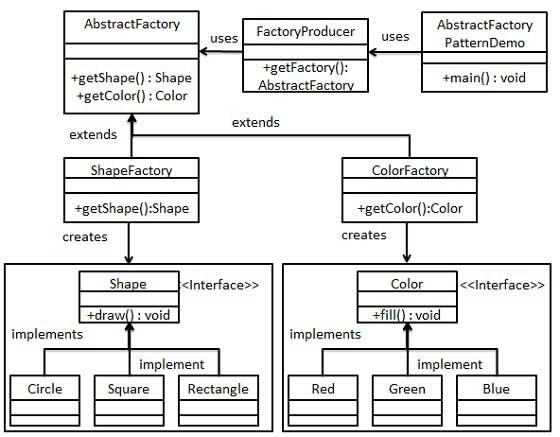设计模式——创建性模式之抽象工厂模式
抽象工厂模式
抽象工厂模式(Abstract Factory Pattern)是围绕一个超级工厂创建其他工厂。该超级工厂又称为其他工厂的工厂。这种类型的设计模式属于创建型模式,它提供了一种创建对象的最佳方式。在抽象工厂模式中,接口是负责创建一个相关对象的工厂,不需要显式指定它们的类。每个生成的工厂都能按照工厂模式提供对象。主要解决接口选择的问题。
优点:当一个产品族中的多个对象被设计成一起工作时,它能保证客户端始终只使用同一个产品族中的对象。
缺点:产品族扩展非常困难,要增加一个系列的某一产品,既要在抽象的 Creator 里加代码,又要在具体的里面加代码。
实现
我们将创建 Shape 和 Color 接口和实现这些接口的实体类。下一步是创建抽象工厂类 AbstractFactory。接着定义工厂类 ShapeFactory 和 ColorFactory,这两个工厂类都是扩展了 AbstractFactory。然后创建一个工厂创造器/生成器类 FactoryProducer。
AbstractFactoryPatternDemo,我们的演示类使用 FactoryProducer 来获取 AbstractFactory 对象。它将向 AbstractFactory 传递形状信息 Shape(CIRCLE / RECTANGLE / SQUARE),以便获取它所需对象的类型。同时它还向 AbstractFactory 传递颜色信息 Color(RED / GREEN / BLUE),以便获取它所需对象的类型。

步骤 1
为形状创建一个接口。
1 public interface Shape { 2 void draw(); 3 }
步骤 2
创建实现接口的实体类。
1 public class Rectangle implements Shape { 2 3 @Override 4 public void draw() { 5 System.out.println("Inside Rectangle::draw() method."); 6 } 7 }
1 public class Square implements Shape { 2 3 @Override 4 public void draw() { 5 System.out.println("Inside Square::draw() method."); 6 } 7 }
1 public class Circle implements Shape { 2 3 @Override 4 public void draw() { 5 System.out.println("Inside Circle::draw() method."); 6 } 7 }
步骤 3
为颜色创建一个接口
1 public interface Color { 2 void fill(); 3 }
步骤4
创建实现接口的实体类。
1 public class Red implements Color { 2 3 @Override 4 public void fill() { 5 System.out.println("Inside Red::fill() method."); 6 } 7 }
1 public class Green implements Color { 2 3 @Override 4 public void fill() { 5 System.out.println("Inside Green::fill() method."); 6 } 7 }
1 public class Blue implements Color { 2 3 @Override 4 public void fill() { 5 System.out.println("Inside Blue::fill() method."); 6 } 7 }
步骤 5
为 Color 和 Shape 对象创建抽象类来获取工厂。
1 public abstract class AbstractFactory { 2 public abstract Color getColor(String color); 3 public abstract Shape getShape(String shape) ; 4 }
步骤 6
创建扩展了 AbstractFactory 的工厂类,基于给定的信息生成实体类的对象。
1 public class ShapeFactory extends AbstractFactory { 2 3 @Override 4 public Shape getShape(String shapeType){ 5 if(shapeType == null){ 6 return null; 7 } 8 if(shapeType.equalsIgnoreCase("CIRCLE")){ 9 return new Circle(); 10 } else if(shapeType.equalsIgnoreCase("RECTANGLE")){ 11 return new Rectangle(); 12 } else if(shapeType.equalsIgnoreCase("SQUARE")){ 13 return new Square(); 14 } 15 return null; 16 } 17 18 @Override 19 public Color getColor(String color) { 20 return null; 21 } 22 }
1 public class ColorFactory extends AbstractFactory { 2 3 @Override 4 public Shape getShape(String shapeType){ 5 return null; 6 } 7 8 @Override 9 public Color getColor(String color) { 10 if(color == null){ 11 return null; 12 } 13 if(color.equalsIgnoreCase("RED")){ 14 return new Red(); 15 } else if(color.equalsIgnoreCase("GREEN")){ 16 return new Green(); 17 } else if(color.equalsIgnoreCase("BLUE")){ 18 return new Blue(); 19 } 20 return null; 21 } 22 }
步骤 7
创建一个工厂创造器/生成器类,通过传递形状或颜色信息来获取工厂。
1 public class FactoryProducer { 2 public static AbstractFactory getFactory(String choice){ 3 if(choice.equalsIgnoreCase("SHAPE")){ 4 return new ShapeFactory(); 5 } else if(choice.equalsIgnoreCase("COLOR")){ 6 return new ColorFactory(); 7 } 8 return null; 9 } 10 }
步骤 8
使用 FactoryProducer 来获取 AbstractFactory,通过传递类型信息来获取实体类的对象。
1 public class AbstractFactoryPatternDemo { 2 public static void main(String[] args) { 3 4 //获取形状工厂 5 AbstractFactory shapeFactory = FactoryProducer.getFactory("SHAPE"); 6 7 //获取形状为 Circle 的对象 8 Shape shape1 = shapeFactory.getShape("CIRCLE"); 9 10 //调用 Circle 的 draw 方法 11 shape1.draw(); 12 13 //获取形状为 Rectangle 的对象 14 Shape shape2 = shapeFactory.getShape("RECTANGLE"); 15 16 //调用 Rectangle 的 draw 方法 17 shape2.draw(); 18 19 //获取形状为 Square 的对象 20 Shape shape3 = shapeFactory.getShape("SQUARE"); 21 22 //调用 Square 的 draw 方法 23 shape3.draw(); 24 25 //获取颜色工厂 26 AbstractFactory colorFactory = FactoryProducer.getFactory("COLOR"); 27 28 //获取颜色为 Red 的对象 29 Color color1 = colorFactory.getColor("RED"); 30 31 //调用 Red 的 fill 方法 32 color1.fill(); 33 34 //获取颜色为 Green 的对象 35 Color color2 = colorFactory.getColor("Green"); 36 37 //调用 Green 的 fill 方法 38 color2.fill(); 39 40 //获取颜色为 Blue 的对象 41 Color color3 = colorFactory.getColor("BLUE"); 42 43 //调用 Blue 的 fill 方法 44 color3.fill(); 45 } 46 }
步骤 9
执行程序,输出结果:
Inside Circle::draw() method.
Inside Rectangle::draw() method.
Inside Square::draw() method.
Inside Red::fill() method.
Inside Green::fill() method.
Inside Blue::fill() method.
(以上知识及实列出自runoob.com 原文链接:https://www.runoob.com/design-pattern/abstract-factory-pattern.html)



